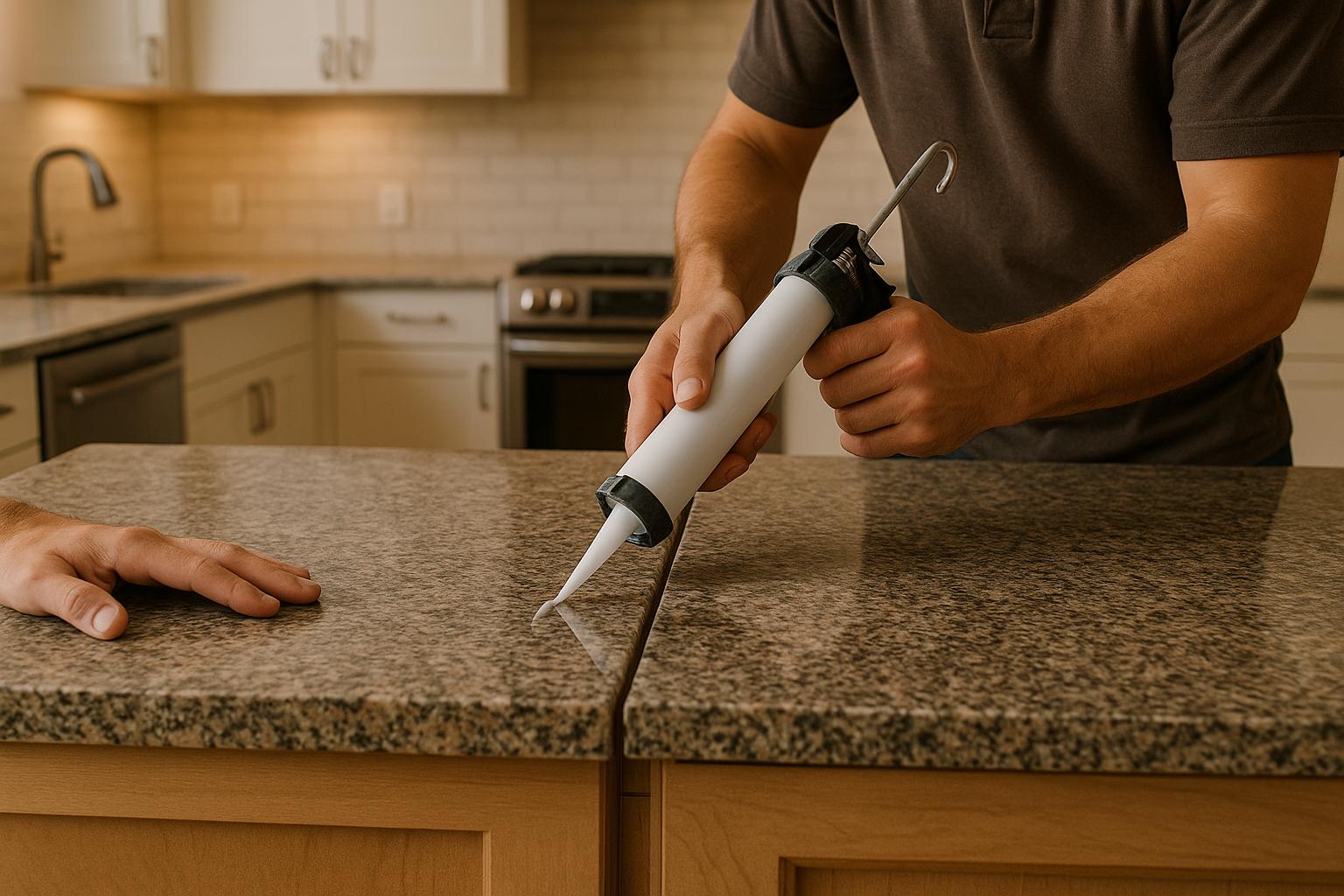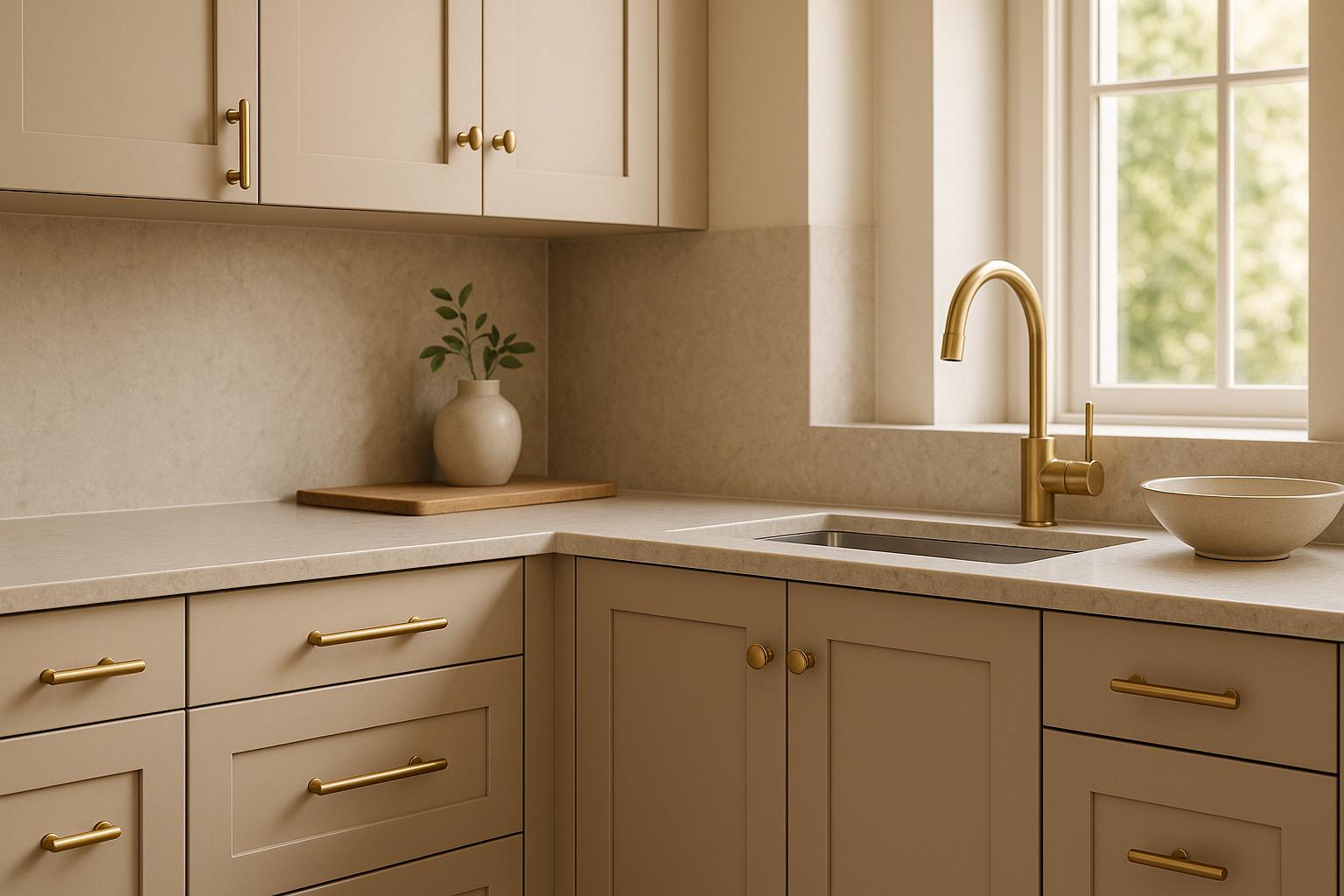Choosing the right adhesive for granite countertops is key to ensuring durability, preventing water damage, and avoiding costly repairs. Granite’s weight and exposure to temperature changes and moisture demand adhesives that are strong, moisture-resistant, and long-lasting. Here’s a quick breakdown:
- Epoxy: Strongest bond (3,000+ PSI), excellent chemical and moisture resistance, but requires careful preparation and mixing. Best for heavy-duty tasks like laminations.
- Polyurethane: Flexible and moisture-resistant, with bond strength up to 2,500 PSI. Easier to apply and suited for areas with temperature changes.
- Acrylic/MMA: Quick curing and strong, but less forgiving during application. Suitable for fast installations.
- Silicone: Best for sealing and moisture protection, especially around sinks and edges. Flexible but not as strong as other adhesives.
Choosing the right adhesive depends on your project’s specific needs, such as strength, moisture resistance, and curing time. Proper installation is just as important to ensure a lasting, polished result.
DIY Granite Countertop Install, Epoxy Joint Filling Tips
1. Epoxy Adhesives
Epoxy adhesives are a top choice for bonding granite countertops, thanks to their ability to create a long-lasting, chemically resistant bond – perfect for the demanding conditions of a kitchen.
Bond Strength
With bond strengths exceeding 3,000 PSI, epoxy adhesives are about six times stronger than polyester alternatives. In fact, tests show that the bond often outlasts the granite itself. This level of durability makes epoxy adhesives ideal for tasks like laminations, rodding, and other applications where a strong, lasting bond is essential. But the benefits don’t stop there – let’s look at how they handle moisture.
Moisture Resistance
Epoxy adhesives form a non-porous, moisture-resistant barrier. This makes them especially effective in areas prone to water exposure, such as sink cutouts and backsplashes, protecting both the joint and the granite from damage.
Curing Time
These adhesives require precise mixing ratios, and their curing times vary depending on the specific formulation and environmental conditions. Proper attention to these factors is crucial for achieving the best results.
Ease of Application
While epoxy adhesives deliver unmatched performance, they require meticulous preparation and technique. Surfaces must be clean, dry, and lightly abraded for optimal adhesion. Compatibility tests are highly recommended to reduce the risk of failure. If repairs are needed, it’s best to use epoxy-on-epoxy bonding, as epoxy doesn’t adhere well to smooth, cured surfaces.
Additionally, epoxy adhesives have a shrinkage rate of less than 2%, which minimizes stress on the bond line during curing and ensures long-term reliability. However, keep in mind that epoxy bonds are permanent – any mistakes during application can be difficult to fix.
2. Polyurethane Adhesives
Polyurethane adhesives are a versatile choice when working with granite, offering flexibility that accommodates both thermal expansion and structural shifts.
Bond Strength
These adhesives provide a solid bond strength ranging from 1,500 to 2,500 PSI, ensuring a reliable hold for granite countertops. What sets them apart is their flexibility. Unlike rigid adhesives that can crack under temperature fluctuations or movement, polyurethane adhesives maintain their grip, adapting to the natural shifts in the material.
Moisture Resistance
One of the standout features of polyurethane adhesives is their resistance to moisture. Thanks to their hydrophobic properties, they perform exceptionally well in wet environments. Interestingly, they even use atmospheric moisture as part of the curing process. This makes them an excellent choice for areas prone to water exposure, such as around sinks, dishwashers, and plumbing fixtures. Their ability to handle moisture ensures a dependable bond, even in challenging conditions.
Curing Time
These adhesives strike a balance between quick setting and workability. They set within 30–60 minutes and fully cure in 24–48 hours, offering a working time of about 15–20 minutes for precise adjustments. Higher humidity can speed up the curing process, making them even more efficient in certain environments.
Ease of Application
Applying polyurethane adhesives is straightforward and user-friendly. Available in cartridges or caulk tubes, they eliminate the hassle of mixing. They bond well to slightly damp surfaces and don’t require the meticulous surface preparation that epoxy adhesives demand. Plus, their repositionable nature gives you a few minutes to make adjustments after application.
That said, temperature plays a crucial role during application. For best results, apply them in conditions between 65°F and 85°F. Cold temperatures can slow down the curing process, while excessive heat may lead to premature skinning, affecting the adhesive’s performance.
3. Acrylic and Methacrylate (MMA) Adhesives
Acrylic and MMA adhesives are known for their quick curing times and durable bonds, making them a popular choice for granite installations.
Bond Strength
These adhesives create a strong, rigid bond on granite’s non-porous surface. This strength allows them to handle heavy loads and endure the daily wear and tear common in kitchen environments.
Moisture Resistance
Moisture resistance varies widely depending on the adhesive’s formulation. Some are engineered to retain their strength in wet or humid conditions, while others may falter, particularly in structural applications. Since granite countertops are regularly exposed to water, humidity, and cleaning products, high moisture resistance is essential. Without it, water can seep in, weakening the bond over time and potentially causing issues like delamination or staining. Always check the technical datasheet to ensure the adhesive meets the demands of your specific setting.
Curing Time
These adhesives cure quickly, which speeds up installation. However, this also means there’s little room for error – once curing starts, repositioning becomes nearly impossible.
Ease of Application
Acrylic and MMA adhesives come as a two-component system, requiring careful mixing according to the manufacturer’s guidelines. The surfaces must be clean and dry before application. Because they set rapidly, efficient and precise work is crucial during the application process.
Next, we’ll dive into the pros and cons to better understand how these adhesives perform overall.
sbb-itb-e397dd0
4. Silicone Adhesives
Silicone adhesives are a great choice for granite countertop projects that need flexibility and strong moisture protection.
Bond Strength
Silicone adhesives create a flexible bond that adapts to granite’s natural thermal expansion and contraction. However, they don’t match the strength of epoxy or acrylic adhesives. Because of this, they are more suited as a secondary adhesive or as a sealing agent for joints rather than the main bonding option for heavy or large granite slabs.
Moisture Resistance
When it comes to dealing with water, silicone adhesives shine. They offer outstanding moisture resistance, holding up well even in environments with constant exposure to water, humidity, and cleaning chemicals.
Thanks to their natural water-repelling qualities, silicone adhesives are perfect for sealing edges and joints around sinks, backsplashes, and other areas prone to moisture. They also help prevent mold and mildew from forming, making them an excellent choice for kitchens and bathrooms.
Curing Time
Silicone adhesives have a moderate curing time, typically needing 24 to 48 hours to fully cure, depending on the surrounding humidity and temperature. While the surface may feel dry within a few hours, the bond gains its full strength over time.
Interestingly, higher humidity speeds up the curing process for silicone adhesives. This is the opposite of many other adhesives and can be a benefit in naturally humid areas like bathrooms and kitchens. Once cured, silicone forms a reliable seal that’s both durable and effective.
Ease of Application
Applying silicone adhesives is straightforward and user-friendly. They usually come in cartridges designed to fit standard caulk guns, eliminating the need for mixing. The adhesive flows smoothly and can be shaped or tooled before it begins to cure.
That said, achieving a neat, clean finish takes a bit of care, especially when creating smooth, even beads along joints. It’s worth noting that once silicone cures, it’s tough to remove, so precise application and initial placement are key to avoiding mistakes.
Pros and Cons
Different adhesives bring their own advantages and challenges when it comes to granite countertops. Here’s a quick breakdown:
- Epoxy adhesives: Known for their strong bond, but they require careful mixing and must be applied quickly.
- Polyurethane adhesives: Provide solid adhesion while allowing flexibility, which helps with the natural movement of the stone.
- Acrylic and MMA adhesives: Cure fast, making them ideal for reducing installation time.
- Silicone adhesives: Stand out for their moisture resistance and flexibility.
Choosing the right adhesive depends on factors like the weight of the granite, the environment where it will be installed, and how quickly the job needs to be completed.
Conclusion
Choosing the right adhesive is all about understanding your project’s specific needs. Each type of adhesive has its own strengths: epoxy is ideal for heavy-duty installations, polyurethane accommodates natural stone movement, acrylic and MMA are perfect for projects with tight deadlines, and silicone performs best in areas exposed to moisture.
For heavy slabs or overhangs, epoxy provides a strong and reliable bond. In environments with temperature changes, polyurethane helps prevent cracking by allowing flexibility.
When moisture is a concern, such as in kitchens or bathrooms, silicone is the go-to choice for areas like sinks and backsplashes. Meanwhile, epoxy is better suited for dry spaces. Keep in mind that the appearance of your finished project can be impacted by your adhesive choice – selecting the wrong one can lead to visible seams or unwanted color bleeding.
Finally, proper installation matters just as much as the adhesive itself. Professional services, like those offered by MI Stone, ensure precise measurements, expert adhesive selection, and flawless application, guaranteeing both durability and a polished look for years to come.
FAQs
What should I look for in an adhesive for granite countertops?
When choosing an adhesive for granite countertops, focusing on strength, moisture resistance, and temperature endurance is key. These factors help ensure the bond remains secure and durable, even with regular use and exposure to changing conditions.
Epoxy adhesives are a popular go-to for granite. They offer impressive strength, are waterproof, and can handle significant weight, making them perfect for keeping your countertops solid and intact over time.
For a polished and professional outcome, you might want to consult experts like MI Stone. Their expertise in granite countertop fabrication and installation can help achieve a seamless and precise finish.
What’s the difference in applying epoxy vs. polyurethane adhesives on granite countertops?
When working with epoxy adhesives, you’ll need to combine two components – a resin and a hardener – before applying the mixture evenly to the granite surface. After ensuring everything is properly aligned, the adhesive requires several hours to cure completely, forming a durable bond.
On the other hand, polyurethane adhesives come pre-mixed and ready to use. They cure faster and usually need the granite to be pressed firmly into place using clamps or weights to guarantee proper adhesion. With a shorter curing time, polyurethane can be a faster solution for certain projects.
Both options work well, but the best choice depends on factors like how quickly you need the bond to set and how complex the application process is.
Why is it important for granite countertop adhesives to be moisture-resistant, and which type works best?
When it comes to granite countertops, moisture resistance in adhesives isn’t just a nice-to-have – it’s a must. This feature keeps water from seeping into the adhesive bond. Without it, the adhesive could weaken over time, which might lead to structural problems or even damage the granite itself.
Epoxy adhesives stand out as the top choice for granite countertops. They’re durable, waterproof, and create a strong bond that lasts. Whether you’re installing countertops indoors or outdoors, epoxy ensures they stay securely in place and maintain their stability for years.



